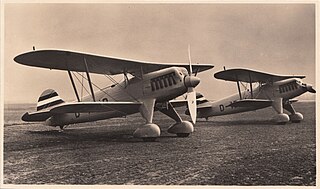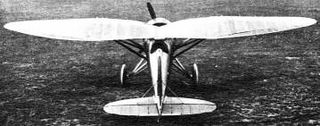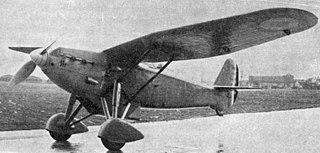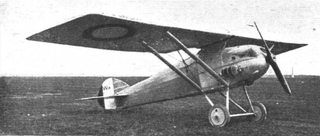Related Research Articles

The Heinkel He 51 was a German single-seat biplane which was produced in a number of different versions. It was initially developed as a fighter; a seaplane variant and a ground-attack version were also developed. It was a development of the earlier He 49.

The Aero A.102 was a Czechoslovakian fighter aircraft that flew in prototype form in 1934. It was developed in response to a Czech Air Force requirement of that year, but was passed over in favour of the Avia B.35.
The Aero Ae 04 was a Czechoslovakian biplane fighter aircraft of 1921. A development of the Ae 02, it was no more successful than its predecessor in attracting purchase orders, and it flew only in prototype form. Undaunted by the lack of interest, development continued as the A.18.

The Seversky XP-41 was a fighter aircraft built in the United States in 1939. A single prototype was modified from the last production Seversky P-35 by adding a new streamlined canopy, a Pratt & Whitney R-1830-19 engine with a two-speed supercharger, and revised landing gear. The XP-41 first flew in March 1939. The aircraft was developed in parallel with the P-43 Lancer, and work was stopped when the USAAC showed a preference for the latter.

The Polikarpov I-153 Chaika was a late 1930s Soviet biplane fighter. Developed as an advanced version of the I-15 with a retractable undercarriage, the I-153 fought in the Soviet-Japanese combats in Mongolia and was one of the Soviets' major fighter types in the early years of the Second World War. Three I-153s are still flying.

The Piaggio P.119 was an Italian experimental fighter of World War II. It had a relatively novel layout, with a "buried" radial engine mounted mid-fuselage. Only a single prototype was built before the Armistice between Italy and the allied armed forces, which ended the project.

The IMAM Ro.57 was an Italian twin-engined, single-seat monoplane fighter of the Regia Aeronautica. Based on a 1939 design by Giovanni Galasso the aircraft did not enter production until 1943.

The Daimler D.I was a German fighter aircraft of World War I. It was a conventional biplane design with a very small interplane gap - the top wing nearly touched the top of the fuselage. Power was provided by a Daimler D.IIIb water-cooled V-8 engine.
The Euler D.I was a German single-seat fighter based on the French Nieuport 17. After seeing the success of the French Nieuport 11 at the front, German designer August Euler set about to create a German aircraft based on the Nieuport design. The Euler D.I first flew in late 1916. It was powered by an 80 hp engine with the Euler patented machine gun on the front.

The Amiot 110, also known as the Amiot-SECM 110, was a French prototype interceptor designed and built in 1929.
The Heinkel Doppeldecker 43 was a prototype German fighter aircraft of the 1930s. A single-engined, single-seat biplane, the HD 43 was designed to meet a secret German Reichswehr requirement for a single-seat fighter. It had two-bay wooden wings with a steel-tube fuselage, and was powered by a 750 hp (600 kW) BMW VI engine. The single prototype flew in 1931.

The Piaggio P.2 was an Italian fighter prototype of advanced design built by Piaggio in 1923.
The Gabardini G.8 was an Italian single-seat aircraft produced in both fighter and trainer versions by Gabardini in 1923.

The ANF Les Mureaux 170 was a prototype French fighter aircraft of the 1930s. It was a single-engined, single-seat parasol monoplane, but only two were built, the type being rejected for service by the French Air Force.

The Potez XI was the first fighter aircraft designed by the French company Potez. Designed in 1922, the only aircraft first flew on December 11 of that year, after which further development work stopped. It was built to meet CAP 2 requirements created in 1919 by the new director of Aeronautics, General Duval. It was to perform bomber, intercept and tactical reconnaissance for the military, as well as escort fighters. The aircraft was to be powered by a turbo-supercharged engine.

The Wibault 3 or Wibault Wib 3 C.1 was a French parasol wing prototype fighter aircraft from the 1920s, designed for high altitude operations. Its development was abandoned after repeated materials failure in its supercharger.

The SNCAC NC-600 was a prototype French twin-engined long-range fighter aircraft, developed by SNCAC from the earlier Hanriot H.220 fighter. The type never entered service, with development being ended by the French surrender in June 1940.
The Potez 230 was a French lightweight single-seat, single-engined fighter aircraft. One prototype was built and flew in 1940, but no production followed, with the prototype being captured and shipped to Germany for study.
The Roussel R-30 was a French light fighter-bomber prototype of the 1930s.
The Romano R.110 was a twin-engine 3-seat fighter aircraft, designed by Etienne Romano in the 1930s. A single prototype was built, but it was not successful, the Potez 630 being preferred.
References
- ↑ "Potez 23".
- ↑ Green & Swanborough 1994, p. 481
- Green, William; Swanborough, Gordon (1994). The Complete Book of Fighters. New York: Smithmark Publishers Inc. ISBN 0-8317-3939-8.